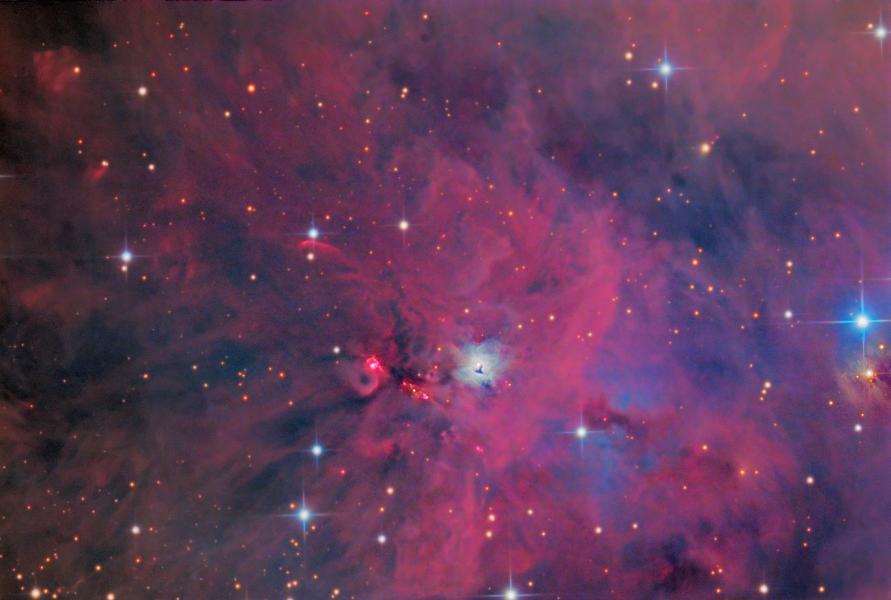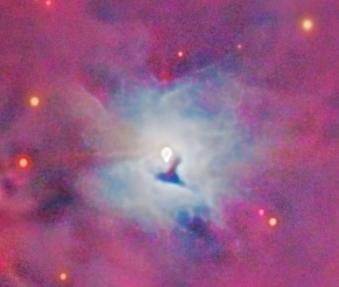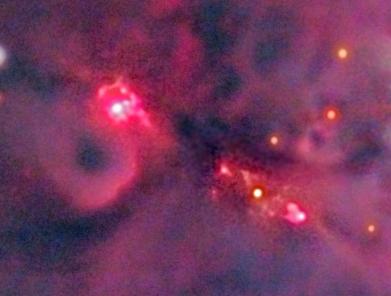The NGC 1999 Region |
 |
NGC 1999 (the bright blue object in the center
of this image) is a a reflection nebula about 2 degrees south of
the famous Orion Nebula. Its most striking feature is the
keyhole-shaped cavity at its center. This cavity was previously
thought to be a dark nebula, one of those many dust clouds that
obscure the light from stars behind them. However, recent
studies of that cavity indicate that it is indeed a hole in the
nebula! Current theories are that a nearby star (specifically,
one of the three stars that make up V380 Orionis, a triple-star
system that is responsible for lighting up NGC 1999) has a polar
jet that is creating the hole!
Speaking of polar jets, see the knots of bright red nebulosity
just to the left of NGC 1999? Those are designated as HH1 and
HH2, short for Herbig-Haro 1 and Herbig-Haro 2. HH-1 and HH-2
were identified by Guillermo Haro and George Herbig in the
1950's. These objects are now known to represent jets of gas
being ejected by protostars (baby stars) and are recognized as
part of star formation. Imagine a disk of dust obscuring the
protostar. This baby star is shooting out jets of gas at high
speed (estimated at 100,000 miles per hour or more) from its
poles. The high-speed gas is colliding with and heating up the
ambient gas and dust in the surrounding area and causing that
gas to glow. Thus, Herbig-Haro objects are usually associated
with star formation. The two HH objects in this image are
actually associated with the same protostar (hidden somewhere in
the dark region that is obscuring dust between the two HH
objects). Think of the jet as being aligned almost horizontally
as composed; the protostar is in the dark region between them.
All the nebulosity visible in this image is part of a huge Orion
molecular cloud complex that includes other notable targets as
the Orion Nebula and the Horsehead nebula.
Source: Robert Gendler, Wikipedia
|
| |
|
Constellation: Orion |
|
When Visible: December - April |
| Distance:
1,500 Light-years |
| Date: January 2014 |
|
Location: Rancho Hidalgo, Animas, NM |
Exposure Details:
L :21 x 10 Minutes Binned 1 x 1
Red: 12 x 10 Minutes Binned 1x1
Green: 12 x 10 Minutes Binned 1x1
Blue: 12 x 10 Minutes Binned 1x1
9 Hours and 30 Minutes Total Exposure Time |
| |
| Equipment Used:
12.5" PlaneWave CDK on a Paramount ME mount. SBIG
STL-6303 camera with 5-position filter wheel and Astrodon
filters. Internally guided with the SBIG internal guide chip. |
| |
| Acquisition Software :
MaximDL 5, TheSky6, CCDAutopilot 5, FocusMax |
| Processing Software:
MaximDL, Photoshop CS5, Carboni Actions, IrFanView, AviStack |
|
|
|
The large image linked to above to is only 75% of the
original sized image. Here are 100% sized crops of the more
interesting features: |




